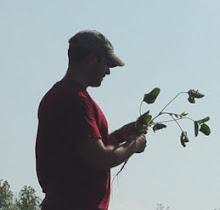The results from the class experiment are in! It's now up to you to figure out just what happened. First a little background on the experimental design.
Experimental design:
As you recall, we discussed many possible factors that may limit the successful overwintering of Dectes in soybean. I've included a copy of the whiteboard scribble-session to spark your memory. Based on a class consensus, you decided to test the effects of stem size using different host plants (soybean versus sunflower). In addition, you agreed that the temperature thermocouples should be placed near the base of the plant and a clump of soil was to be used to insulate the base of the plant. In short, the goal was to simulate field conditions as much as possible and only alter stem size. On Friday, we (my student worker and I) collected "fresh" sunflower and soybean plants from the Agronomy North Farm and weighed out an equal amount of soil for each of the test plants using an electric balance (~1700 g/plant). Note, it rained heavily on Thursday and all the samples (stalks and stems) were quite wet.


After samples were collected from the field, we immediately drilled them with a cordless drill at the base off the plant and placed thermocouples down into the base of each stalk or stem. We then used a small piece (same size for each experimental unit) of duct tape to secure the wire to the stalk.
The temperature inside the plants were measured for 5 min prior to placing them inside the freezer. The experiment was stopped after 145 minutes or when the rate of cooling decreased considerably.
Results are posted below. Note, "xsun", "xsoy", and "control" are the mean temperatures for the 3 replicates. I included a "control" treatment where a set of thermocouples were placed on the outside of the plant stalks and stems; this was done to measure the changes in external temperature. Since each line is made up of >12,000 points, I excluded error bars for simplicity. However, the variability between points was very small (standard errors around all points were never greater than plus or minus 0.5 degree C).
Discussion.
For the experimental design, feel free to include details that I may have missed. What was the class hypothesis? What were the other hypotheses discussed? What happened in your experiment? Does this "prove" or "disprove" your hypothesis? Could you draw these conclusions without the "control" data points? What effect, if any, would cold temperatures (below 0 degrees C) have on Dectes larvae that would be overwintering in these different host plants? Recall, the two supercooling points that we obtained in class were -15.4 and -17.6 degrees C. Did the rain have any effect on your results? If so, how could you test for such an effect? Where there any other possible sources of experimental error that you didn't account for in the current experiment?

















